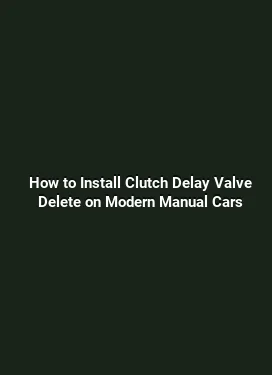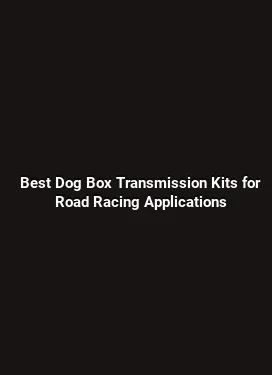Limited Slip Differential vs Welded Diff for Drift Cars: Pros and Cons
Overview of Differential Options for Drifting

Drifting places unique demands on the drivetrain, where predictable power delivery, tire management, and consistent lock behavior influence the ability to initiate and sustain slides. The two most common differential approaches for drift builds are Limited Slip Differentials (LSD) and welded differentials. Each option carries distinct characteristics that affect grip, steering response, tire wear, and long-term reliability. Understanding how these differentials behave under throttle, weight transfer, and steering input helps drivers tailor their setup to their skill level, vehicle weight, and track conditions.
A Limited Slip Differential uses internal clutches or gears to limit the difference in rotational speed between the left and right drive wheels. This constraint improves traction when one wheel is on low-traction surface or during mid-corner transitions. A welded differential, by contrast, locks both wheels together so they rotate at the same speed, regardless of traction conditions. The locked state can deliver aggressive yaw responses and easier initiation on dry surfaces, but it also amplifies understeer or oversteer tendencies and can increase tire wear on non-uniform surfaces. The choice between these two options influences how a drift car behaves, how the chassis communicates grip to the driver, and how forgiving the setup is during high-velocity slides.
Limited Slip Differential: How It Works and Its Practical Benefits
An LSD typically employs clutches, helical gears, or viscous coupling to limit slip between the wheels. In plain terms, the LSD tries to keep wheel speeds coordinated, so the inside and outside wheels don’t diverge too far from each other during cornering or throttle-induced shifts. For drifting, this coordination translates into more controlled power delivery and improved predictability when exiting a corner or transitioning into a slide.
One of the biggest advantages of an LSD is enhanced traction on the outside wheel when the inside wheel has reduced grip. This means more consistent smoking tires on dry tarmac and easier initiation at lower RPMs because the limited slip helps transfer torque to the wheel with more traction. The friction or pre-load settings inside the LSD can be tuned to change how aggressively the differential locks under throttle or braking, which directly impacts how smoothly a drift can be started and maintained.
Torque Bias and Lockup Behavior

Torque bias refers to how power is distributed between the two driven wheels. In performance LSDs, clutches or gears are preloaded so that, under normal conditions, some differential action exists to allow for cornering. When a drift begins, the LSD should progressively lock, increasing the transfer of torque to the outside wheel. This behavior improves stability in a high-angle slide and reduces the tendency for the inside wheel to scramble or lose traction. However, if the lock is too aggressive, the car can become twitchy at the limit and require more precise throttle modulation.
Maintenance and Longevity
Limited slip units generally require periodic maintenance such as fluid changes, clutch pack inspection, and sometimes shim adjustments to maintain preload. The exact service intervals depend on the design (plate-type, gear-type, or viscous LSD) and usage pattern. For drift applications, heat and sustained high-load conditions can accelerate wear in clutch packs or other locking components. A well-maintained LSD keeps gradual engagement characteristics intact, preserving predictable steering response and tire life across sessions.
Welded Differential: When Simplicity Becomes a Performance Decision
A welded differential is, in essence, a solid lock between the two drive wheels. In practice, the differential housing is welded shut so both wheels rotate at the same speed at all times. This setup is simple, robust, and inexpensive to install, and it can deliver immediate and decisive yaw behavior when initiating slides on dry pavement. Welded diffs are a common choice for budget drift builds or for drivers who prioritize aggressive predictability and a raw, direct connection to the rear axle.
On the downside, a welded diff removes the nuance of traction-based speed balancing. When the track surface changes or one tire loses grip, both wheels are forced to rotate at the same rate, which can lead to sudden oversteer or understeer depending on the car’s weight distribution and suspension setup. Tire wear tends to be more rapid and even more uneven if the car experiences frequent throttle-induced torque shifts. The stiff lock also makes precision steering at the limit more demanding, particularly on bumpy surfaces or during long sessions where heat builds up in the rear end.
Immediate Lock vs Progressive Lock
With a welded diff, lock is effectively instantaneous and constant. This predictability is useful for a driver who wants to “feel” the car respond instantly to throttle input. However, the lack of progressive lock means there is little to no friction-based modulation when approaching a corner or transitioning through a slide. In practice, this can translate to a more abrupt shift in yaw angle and a steeper learning curve for drivers who rely on weight transfer and throttle modulation to manage the drift angle.
Durability and Cost Considerations
From a durability standpoint, welded diffs boast exceptional robustness because there are fewer moving parts to wear out. They also cost less upfront compared to some high-end LSDs. For a drift enthusiast building a car on a tight budget, a welded diff offers a straightforward path to a functional rear-end setup. Maintenance is relatively simple—there are no clutch packs to replace and the primary concern becomes the integrity of the welds and the surrounding components under heat and load.
Practical Considerations: Vehicle Setup, Track Conditions, and Driver Style
Choosing between an LSD and a welded diff is not only about the differential itself. It involves a broader assessment of the chassis, suspension geometry, steering axis, weight distribution, tire choice, and track conditions. A drift car’s handling envelope is shaped by how torque is delivered to each rear wheel, how much front-end grip exists, and how quickly the rear tires can shed or absorb energy during a transition.
Track conditions play a significant role. On dry asphalt, an LSD can offer more controlled initiation and smoother transitions between angles. On damp or partially wet surfaces, the traction benefits of an LSD become more pronounced, helping to keep the outside wheel engaged and reducing sudden snap under throttle. A welded diff, while effective in dry environments for aggressive slides, can become unstable on slick surfaces due to the lack of differential action, making it harder to recover from a loss of grip without rapid steering corrections.
Tuning and Setup Strategies
Tuners and drivers can tailor LSD performance through preload adjustment, friction plate selection, or by choosing a torque-biasing mechanism that matches the driver’s style. In drift-specific setups, a slightly higher preload can promote a quicker lock during mid-corner transitions, which can help with aggressive angles. Conversely, a lighter preload yields more wheel speed differentiation, which some drivers prefer for smoother exit transitions and better throttle modulation at the apex. When assembling a welded diff, the emphasis is on ensuring the weld is consistent and that the rear axle housings and bearings can handle the increased torque without flexing or binding. A welded diff’s predictability is attractive, but it demands consistent steering and precise throttle control to maintain slide angles without abrupt corrections.
Weight Distribution, Suspension, and Steering Interaction
The interaction between diff behavior and suspension geometry is critical. A well-balanced weight distribution helps maintain predictable tire contact patches during a drift, while a tuned suspension can compensate for the lock characteristics. For LSD setups, choosing a compatible differential oil viscosity and viscosity grade can influence heat dissipation and frictional behavior, which in turn affects the duration of a stable lock during a long slide. For welded diffs, the chassis is often tuned to handle the increased abruptness by adjusting camber, toe, and anti-squat settings to maintain tire contact and reduce inside tire scrub during transitions.
Real-World Scenarios: Drifter Profiles and Vehicle Classes
Drivers with a more aggressive throttle approach and a preference for quick, snappy transitions may gravitate toward a welded diff for its immediate lock and raw feel. This choice tends to shine on well-prepped tracks where grip conditions are consistent and the driver can manage the balance with precise steering inputs. On the other hand, drivers who value gradual, controlled power delivery, improved corner-exit traction, and tire wear management typically favor an LSD. The LSD’s ability to distribute torque more intelligently across the rear axle can translate into smoother transitions and a wider window of controllable angles, especially for beginners or intermediate drivers working on line consistency.
Different Drifter Archetypes
For experts focusing on precision slide control and consistency during long sessions, LSD-equipped setups often provide a more forgiving envelope at the limit. For those who enjoy the pure, unfiltered feel of a locked rear end and are comfortable managing a harsher sportier feel, a Welded Diff can deliver the desired drama on dry surfaces. Car classes with heavier rear wheels or near-neutral weight distribution may benefit from the LSD’s traction symmetry, while lighter, rear-wheel-drive builds with a strong center of gravity might respond differently to the welded approach. In practice, many teams experiment with a hybrid mindset—starting with a welded diff for initial testing and then upgrading to a well-tuned LSD to balance performance and reliability during competition seasons.
Maintenance, Reliability, and Long-Term Ownership
From a maintenance perspective, LSDs require attention to clutch wear, gear mesh, and lubrication. Regular inspection of seals, preload shims, and gear contact patterns helps prevent drift-related failures and ensures consistent performance. Welded diffs, while mechanically robust, demand a careful check of axle bearing wear and differential housing integrity after heat cycles and heavy use. Both options benefit from proper cooling during long sessions and from using the appropriate diff oil or lubricant as specified by the differential design.
Operational Tips for Drifters
1) Monitor tire temperatures and wear asymmetry to gauge how the diff is influencing grip distribution across the rear axle. 2) Practice throttle modulation and steering inputs to exploit each differential’s characteristic—LSDs respond well to measured throttle bumps that encourage progressive lock, while welded diffs reward quick, decisive throttle bursts and precise steering. 3) Track setup should align with the diff choice—stiffer rear springs and tuned anti-roll bars can compensate for the diff’s lock behavior. 4) Regularly inspect the differential mounting points and drive shaft connections since high-angle slides impose additional torque on these interfaces. 5) Consider heat management—diffs generate heat, and excessive temperatures can alter lock response and wear patterns, especially during continuous sessions.
Conclusion-Free Understanding: Choosing the Right Differential for Your Drift Goals
Choosing between a Limited Slip Differential and a welded differential for drift applications is a balance between control, predictability, and the steering feel you want to cultivate. LSDs offer refined handling, improved traction on varying grip surfaces, and a tunable lockup that can adapt to driver skill and track conditions. Welded diffs emphasize raw, immediate lock, simplicity, and cost-effectiveness but demand careful control inputs and a tolerance for steeper handling curves. The best approach combines a clear understanding of your driving style, the track profile you race on, and a maintenance plan that keeps selective wear in check. Through thoughtful selection and methodical testing, the optimal rear-end setup emerges as a natural extension of the chassis, suspension, and driving philosophy, turning raw mechanical concepts into predictable, repeatable performance on the track.






